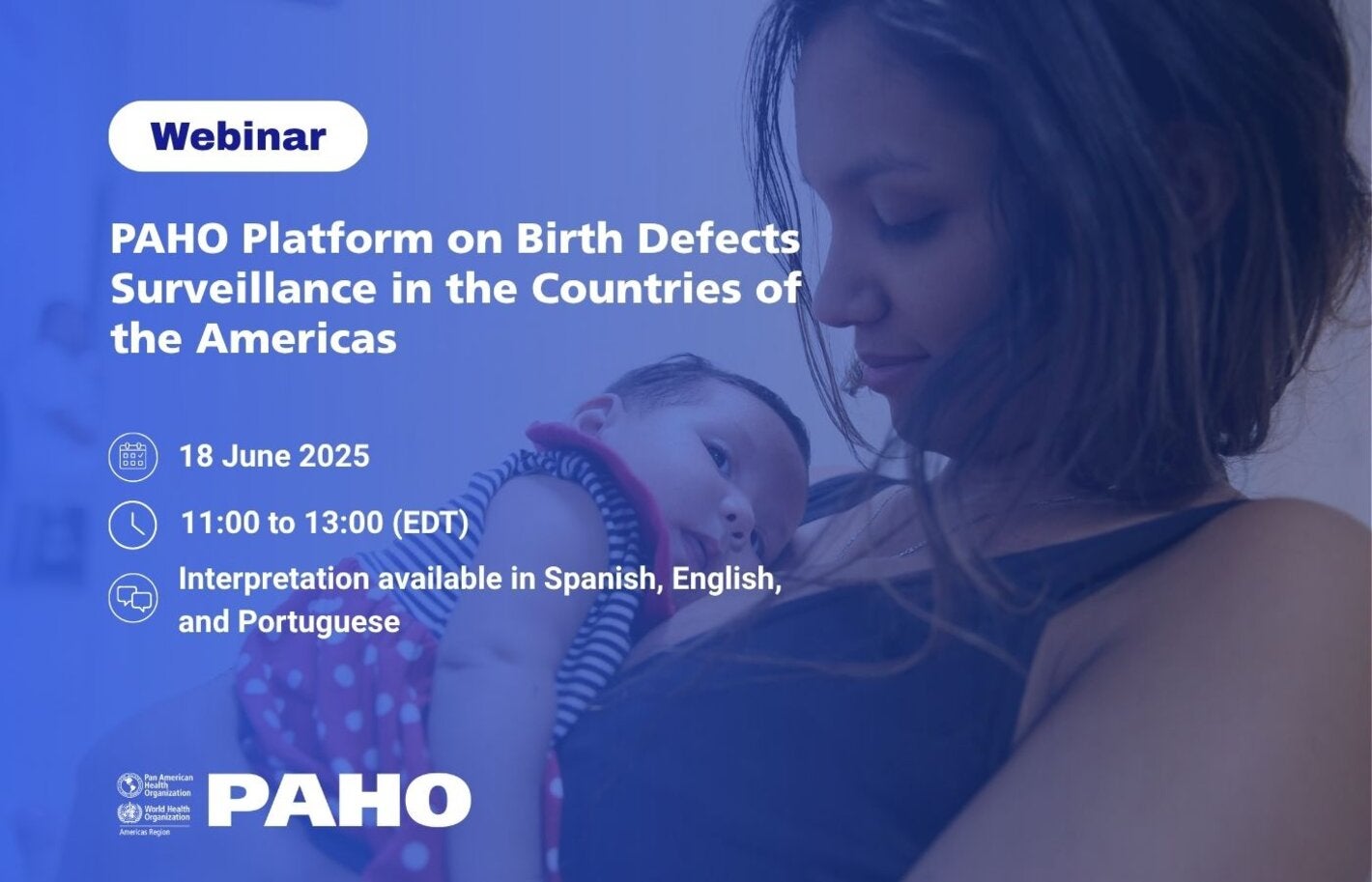
Webinar: PAHO Platform on Birth Defects Surveillance in the Countries of the Americas
Date: 18 June 2025
Time: 11:00 a.m.to 13:00 p.m. (EDT)
Simultaneous interpretation in Portuguese, Spanish, and English
🔗 Register here
Background
In the Region of the Americas, approximately 15 million births occur annually, of which 10 million are registered in Latin America and the Caribbean (LAC). The burden of disease and disability associated with adverse perinatal outcomes, such as complications from prematurity, congenital defects, sepsis, or asphyxia, represents 15 million Disability-Adjusted Life Years (DALYs). More than 50% of mortality in children under five years of age occurs during the first month of life, mainly due to complications from prematurity, congenital defects, sepsis, and asphyxia. These issues have an immediate impact in terms of health and quality of life, as well as costs for health systems. The impact on human capital and economic costs for families, health systems, and societies is observed both in the short and long term[1] [2].
Genetic and hereditary factors, chromosomal abnormalities, environmental and nutritional factors, exposure to toxic substances and medications, radiation exposure, and chronic or infectious diseases during pregnancy, among other determinants, are associated with congenital defects[3]. The Region of the Americas has a strong and extensive history in congenital defect surveillance systems. Many of these systems began in the late 1960s and 1970s, leading to numerous countries with significant experience in their implementation[4].
At the 63rd World Health Assembly[5], held in 2010, a resolution on congenital defects was approved to address widespread concerns regarding the lack of recognition of their global burden and the limited resources for their prevention and treatment. The resolution urged the Member States of the World Health Organization (WHO) to prioritize surveillance, prevention, and care for these conditions. It called on governments, civil society, and the general public to raise awareness about the importance of congenital anomalies and to mobilize policies and programs aimed at reducing the morbidity and mortality associated with them through the integration of these conditions into existing maternal, reproductive, and child health services. Additionally, it emphasized the social well-being of all individuals affected by these defects.
Currently, 14 countries in the Americas implement national congenital defect surveillance programs. However, it is necessary to strengthen this strategy to monitor the disease burden of a group that represents the second leading cause of mortality, illness, and disability. Strengthening surveillance will also allow for the assessment of the impact of environmental determinants, chronic or communicable diseases on perinatal health. Thus, in addition to addressing these conditions, it is crucial to enhance surveillance in response to emerging situations, such as the experience faced during the Zika virus emergency and the current challenge with Oropouche.
The Pan American Health Organization (PAHO) supports countries in strengthening congenital defect surveillance systems to generate evidence for informed decision-making, provide alerts in case of emergencies requiring specific and immediate responses, and evaluate implemented actions. This strengthening also aligns with mandates established by PAHO and WHO governing bodies.
Objectives
- Present the PAHO platform on congenital defect surveillance.
- Analyze the experience of countries in the Region in implementing congenital defect surveillance and their challenges.
- Discuss the relevance of having consolidated data on congenital defects for the Region and encourage countries to strengthen congenital defect surveillance and contribute to the regional surveillance and response platform.
Agenda
Welcome and Opening Remarks
James Fitzgerald, Director, Department of Health Systems and Services, PAHO
Platform for Congenital Defect Surveillance
HSS/WH y EIH/IS
Experiences and Challenges of Countries in Congenital Defect Surveillance
Argentina, Brazil, Colombia, Costa Rica, and Cuba
Questions and answers
Closing Remarks
Sebastián García Saiso, Director of the Department of Evidence and Intelligence for Health Action, PAHO
References
[1] United Nations Inter-agency Group for Child Mortality Estimation (UN IGME), Levels & Trends in Child Mortality: Report 2024 – Estimates developed by the United Nations Inter-agency Group for Child Mortality Estimation, United Nations Children’s Fund, New York, 2025. https://childmortality.org/wp-content/uploads/2025/03/UNIGME-2024-Child-Mortality-Report.pdf
[2] PLISA - Open Data portal of the Pan American Health Organization (PAHO/WHO). Core Indicators Dashboard. https://opendata.paho.org/en/core-indicators/core-indicators-dashboard
[3] Worls Health Organization, Fact sheets: Congenital disorders. 27 February 2023. https://www.who.int/news-room/fact-sheets/detail/birth-defects
[4] Durán P, Liascovich R, Barbero P, Bidondo MP, Groisman B, Serruya S, et al. Sistemas de vigilancia de anomalías congénitas en América Latina y el Caribe: presente y futuro. Rev Panam Salud Publica. 2019;43:e44. https://doi.org/10.26633/RPSP.2019.44
[5] World Health Assembly, 63. (2010). Birth defects. World Health Organization. https://iris.who.int/handle/10665/3091
